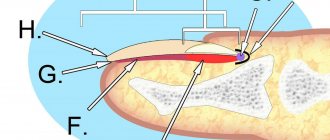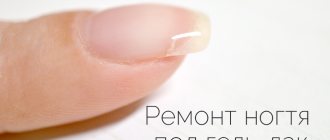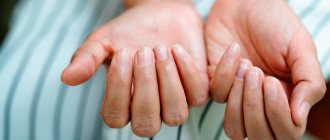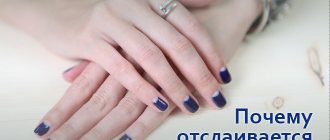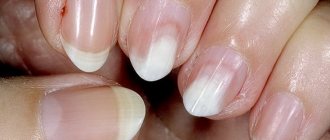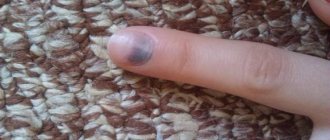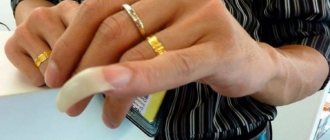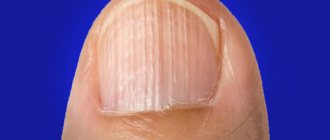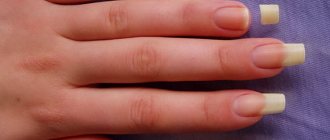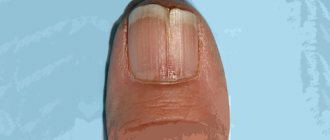Nail diseases are widespread. Many, seeing changes in the nail plate, do not know who to turn to for diagnosis, and miss precious time when they can correct something and get rid of the disease forever. Neglected cases lead to severe disease and irreversible consequences.
Women with long-term use of gel polishes, patients with anemia or protein-energy deficiency often experience splitting of the nail plate. Understanding the causes and finding out which direction to move when identifying nail diseases is very important, as this can help in diagnosing more dangerous conditions.
Acquired onychodystrophy often takes the form of onycholysis. This pathology is characterized by a change and lack of connection between the plate and the bed; the matrix remains intact. Detachment of the nail from the distal edge is observed when the nail plate is unable to adhere to the bed. Below we will analyze the main reasons for the development of onycholysis.
Why does the plate peel off from the nail bed and what does it mean?
Genetics
In people suffering from autoimmune diseases, there is a hyperreaction of the immune system with the subsequent development of autoimmune inflammation and disruption of the integrity of healthy tissues.
The following symptoms are typical for this type of disease :
- thickening and deformation;
- rough surface;
- delamination;
- dullness of the nail with dotted, linear white or black inclusions;
- change in shape, similar to a saucer in the center of the nail;
- inflammation of the cuticle.
Poor quality care and manicure
When performing a manicure, the master must comply with all sanitary and hygienic rules for serving the client. Manicure instruments must undergo mandatory sterilization and disinfection.
Detachment of the nail plate can occur both after salon procedures and as a result of inappropriate care at home, for example:
- too frequent nail extensions and gel polish application;
- low-quality nail care products;
- using nail polish remover with acetone;
- inaccurate filing of nails - it is not recommended to move the file in different directions; you need to hold the tool at an acute angle to the nail plate;
- mistakes when removing nail polish.
Work specifics

Harmful working conditions can also cause nail peeling. Diseases can be caused by dangerous components included in household chemicals, as well as by mechanical factors and damage to nails when performing the same work with your hands.
The following professions deserve special attention:
- typist;
- cook;
- hairdresser;
- workers;
- cleaners;
- employees of laundries, dry cleaners, car washes.
The main symptoms of onycholysis associated with work activities:
- yellow tint of nails;
- longitudinal grooves of the nail;
- lack of smoothness and shine;
- impressions of the nail plate;
- fragility and porosity of the nail;
- splitting of the nail plate in the transverse direction.
Lack of vitamins
The development of vitamin deficiency disrupts the structure of the posterior part of the nail plate - the matrix. Externally, a lack of vitamins (vitaminosis) affects differently :
- separation of the nail surface;
- the appearance of white transverse stripes;
- mottled with yellowish stripes;
- yellow nails;
- fragility and curvature;
- the presence of shapeless spots or inclusions.
Nervousness

Nervousness triggers the development of many diseases. Symptoms associated with mental imbalance sometimes manifest as:
- growths of the nail;
- fragility;
- whitish-blurred nail color;
- uneven and rough surfaces;
- inflammation of the cuticle.
Hand injuries
If the hands are injured, the nail plate may be torn off. However, this area is characterized by rejection of the nail sheet over time, not immediately. The most typical types of impacts and injuries :
- pinched finger;
- injury;
- compression.
Therapy for injuries is a long process: the nail grows back over several months.
Often an overgrown nail shows signs of deformation.:
- lack of connection between the outer edge and the bed;
- partial bifurcation of the nail during growth transversely or longitudinally;
- depressions;
- saucer-shaped deformities;
- whitish or dark spots.
Hormonal imbalances

And nails are no exception! Malfunctions of the thyroid gland have the most significant effect , causing nail detachment.
Typical violations:
- fragility and brittleness of nails;
- porosity and unevenness of the plates;
- loose nail surface;
- yellowing and fading.
Fungus
In first place among the causes of split nails is fungus (forty percent of the total number of diseases). According to modern scientific data, more than two hundred mycobacteria have been identified. The main action of the fungus is aimed at destroying bonds. Let's look at the characteristic features:
- rough and furrowed nail plate;
- yellowed and thickened;
- detachment of the nail from the inner edge;
- saucer-shaped notch in the center.
Medicines

- beta receptor blockers;
- antibiotics: fluoroquinolones and tetracycline;
- lithium preparations.
While taking it, the following nail growth disorders may occur::
- fragility;
- whitish-gray tint;
- formation of depressions;
- disturbances in the structure of the nail layers (thickening);
- appearance of roughness.
Diseases
There are a number of diseases, both acute and chronic, in which nail peeling can occur. The most common systemic diseases associated with this disease are the following :
- gastrointestinal, such as gastritis or ulcers;
- of cardio-vascular system;
- nervous system;
- endocrine disorders;
- skin diseases: atopic dermatitis, bullous dermatosis, eczema and psoriasis.
Causes
Most often, a toenail comes off when a natural pedicure is neglected, so the girl herself is usually to blame for the problem.
The main myth that many people encounter when such damage occurs is that the surface can recover spontaneously. In fact, the cosmetic defect gradually progresses, which can eventually lead to complete destruction of the toenail.
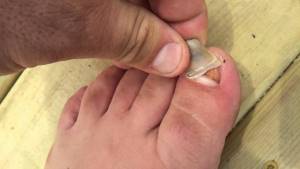
Most often, defects on the legs arise due to the aggressive influence of external factors:
- Mechanical damage (pinching, bruising, fracture) of a finger or foot. In this case, the plate becomes deformed and blood circulation worsens.
- Illiterate pedicure. Careless use of sharp instruments increases the risk of surface damage.
- Using low quality ingredients when visiting a salon.
- Wearing uncomfortable, tight shoes that restrict movement.
Such factors gradually lead to small detachments, and then affect the general condition of the legs.
There are also a number of health problems that can cause defects:
- Poor circulation;
- Deterioration of general or local immunity (for example, after a recent illness or long-term use of medications);
- Fungal infection;
- Lack of vitamins and microelements in the body;
- Dysfunction of organs and systems;
- Diseases of the nervous system.
Since a girl cannot always notice internal pathologies in a timely manner, their presence can be determined if serious problems with the health of her arms or legs are detected.
Diagnostics
The diagnosis of onycholysis is made by a dermatologist as follows::
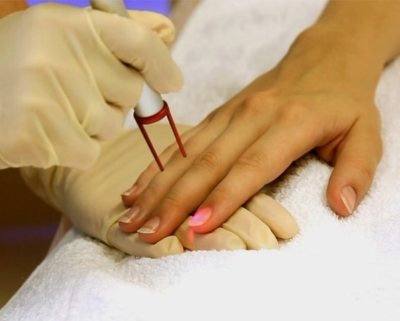
- Visually. During examination, attention is paid to the presence of arched transverse grooves up to 1 mm deep (Bo lines).
They indicate the severity of the lesion, indicate frequent injuries or indicate the presence of somatic diseases.The number of affected nails, their color, shape, structure, and the condition of the plate help make a clinical diagnosis.
- Scraping of the nail bed is performed to diagnose the presence of pathogenic microorganisms. The study makes it possible to exclude or confirm mycotic or bacterial damage.
- At the end of the differential diagnosis, the symptoms identified in the patient are compared with signs of diseases such as:
- fungus;
- lichen;
- psoriasis;
- skin cancer;
- atypical onychodystrophies.
Treatment
To completely restore your nails, you need to promptly begin to eliminate the reason why they begin to peel off. Since the problem is not just a cosmetic defect, it develops in an open form, so a woman can notice it almost immediately and begin treatment in a timely manner.
The first signs of symptoms can be detected 1-2 days after the pathogen appears, which simplifies the process of rehabilitation of the pedicure area. Symptoms begin with a slight detachment of the nails, their significant thinning or thickening and short-term preservation of the decorative coating.

In the initial stages, you can restore the coating yourself; to do this, follow the following procedure:
- Balance your diet. To do this, be sure to include cereals, cereals, vegetables, and reduce fat intake. Additionally, it is recommended to add vitamin courses to improve immunity.
- Take steam baths daily. It is recommended to add auxiliary components to them: sea salt, potassium permanganate, baking soda, essential oils.
- Wipe the affected area with iodine every day before going to bed.
- If the surface is damaged due to injury, pay attention to personal hygiene. To do this, you need to wash your feet 2 times a day and wipe your finger with an antiseptic every 2-3 hours.
- Use medicated varnishes to strengthen the surface (for example, Loceryl).
The more attention you pay to restoring the pedicure area, the higher the chance of preventing complications.
What processes can be identified during onycholysis?
- Rejection of the plate from the bed in the area of the leading edge, detachment from the side and at the base of the holes.
- A healthy nail is transparent; if it turns whitish-gray, then there is air in the bed space.
- A change in color in the yellow-brown palette helps to suspect the presence of microbes.
- The greenish color is characteristic of Pseudomonas aeruginosa.
- With mycosis, the smoothness of the nail surface is lost, roughness appears, and the nail is also easily deformed.
- Hyperkeratosis gradually forms due to dirt and dead cells entering the subungual space.
- There is a risk of secondary foci of infection.
- Onycholysis is characterized by both complete and partial rejection of the plate.
What to do if a toenail falls off?
Treatment should begin with a visit to a dermatologist or pathologist, so that the doctor examines the damaged area and prescribes a rehabilitation regimen. Since the nail has already fallen off, it will not grow back spontaneously, which is why going to the hospital is a mandatory step for a woman.
If the nail does not fall off completely, the doctor usually prescribes vitamin complexes and the use of local compresses that will fix the affected area. Sometimes in this case, surgical removal of the plate is prescribed, which will prevent the emergence of pathogenic microflora on it, which can damage the matrix.
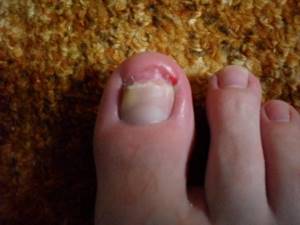
If the matrix (base) of the toenail remains healthy, complex therapy is prescribed for the gradual regrowth of the coating:
- Perform steam baths daily. Add sea salt, baking soda, essential oil, and potassium permanganate to them.
- Every day before going to bed, wipe the surface with iodine.
- Use restorative, strengthening varnishes (Loceryl) and ointments that will speed up nail restoration (Nailtivit).
- In the presence of a fungal infection, antimycotics are prescribed - Lamisil, Exoderil, Mikozan.
- In case of dysfunction of organs or systems in a girl’s body, the doctor prescribes appropriate medications.
If you fully comply with the doctor's instructions, you can restore a natural pedicure 3-4 months before the surface completely regrows.
What to do?
If the cause of detachment is injury
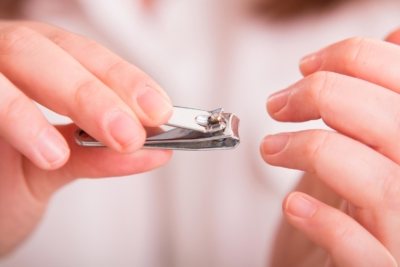
In case of incomplete rejection of the nail sheet on the thumb and other fingers in case of mechanical damage, which is not uncommon, the following should be done:
- The affected nail is trimmed daily.
- After which they are treated with a disinfectant.
- The treated area should be covered with a bactericidal patch for the rest of the day.
Surgical methods are used for complete detachment or for a large area of damage . The intervention is carried out by opening the nail bed, removing hyperkeratotic masses, hematomas and the source of contamination.
After surgery, daily dressings are required with mandatory treatment with antibiotics and antiseptics. During the recovery period, solutions with gelatin are used, which have proven to be a very effective remedy.
Microbial damage
Streptococcal or staphylococcal infection
Treatment is carried out using synthomycin gel and heliomycin ointment. Directions for use: treatment of the cuticle and affected area twice a day. Anti-inflammatory drugs are also used in addition to the main treatment.
Effective for local treatment:
- Levomekol ointment;
- preparations based on birch tar;
- Vishnevsky ointment.
Lotions and glycerin dressings are also used.
Candidal mycosis
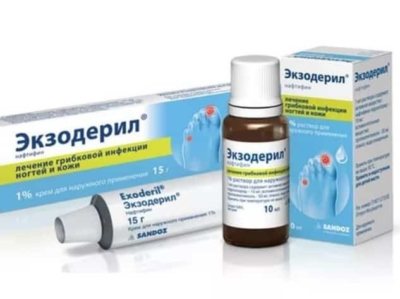
Basis of therapy: antimicrobial drugs such as:
- “Mikospor” (“Bifonazole”);
- “Loceryl” (varnish is applied once a day);
- “Ketonazole”;
- “Itrazol”, “Itramikol”;
- “Batrafen” (varnish-based ciclopirox).
The use of Exoderil has shown its antifungal effect better than others . The drug is applied to the infected area and nearby areas twice a day.
In severe cases of the disease, antifungal drugs should also be used orally.
Systemic diseases
In this case, onycholysis therapy primarily involves treating the underlying disease that caused the peeling of the nail plates.
Stages of treatment of the disease:
- Vitamin therapy - taking vitamins (C, A, group B, beta-carotene) and microelements (iron, calcium, sulfur, zinc, copper).
- Application of “Solcoseryl” (ointment for external use). The product belongs to the group of biogenic stimulants and activators of metabolism in tissues and has powerful regenerating properties.
- Antihistamines.
- Physiotherapy.
- Nutrition.
If the disease was caused by an allergy or pathology of the digestive system, then it is appropriate to resort to diet therapy.

Can be used as therapy:
- vitamin and mineral complexes;
- antihistamines;
- fish fat;
- Dietary supplements containing amino acids.
Poor nutrition causes slow growth of the nail plate, which leads to its deformation. Patients suffering from onycholysis should include the following nutritional components in the menu :
- gelatin;
- fresh fruits;
- boiled vegetables;
- animal and vegetable proteins;
- nuts, seeds.
Traditional methods of treating nail plate detachment
The main methods consist of taking strengthening baths and lotions.
Here are some recipes:
- Salt bath with potassium permanganate . Dilute a tablespoon of sea salt with hot water and leave for half an hour, then immerse your hands in it. After the bath, wipe your hands dry and apply the medicine.
- Lotion with a paste of oil and garlic . Chopped garlic (5 cloves) is mixed with butter in equal proportions and rubbed into the affected area.
- Iodine . Just apply to your nail plates overnight.
- Propolis is used in the form of night lotions from its infusion.
- Herbal decoction:
- A mixture is prepared from equal proportions of dried oak bark, celandine herb, lilac and calendula flowers.
- The mixture obtained and thoroughly mixed is poured with hot water (temperature about ninety degrees).
- Then the resulting mixture should be placed on the stove and simmered for about ten minutes.
- Then the broth is cooled to room temperature and a twenty-minute therapeutic immersion of the hands is performed.
- Self-massage of fingers . This is done daily. Slowly, gently massage the nails in circular diverging movements in the direction of growth of the nail plate, working more diligently on the fingers with affected nails.
- Gelatin baths . About three grams of gelatin is poured into two hundred milliliters for half an hour. The solution is heated until the gelatin is completely dissolved (without boiling), after which it is cooled. Baths are carried out three times a week.
How to provide yourself with first aid, what should you do?

Find out what to do if you receive a mechanical or chemical injury to your nail, it falls off or begins to peel off, from the following instructions:
- Apply a cold compress to the injured area.
- Wrap your finger with an elastic bandage - it is acceptable to slightly tighten it.
- If the nail begins to peel off, you can apply a gauze compress soaked in apple cider vinegar and vegetable oil.
The situation is more complicated if the cause of nail detachment is a fungus. Here you can no longer do without medical consultation. Remember that self-medication is simply dangerous.
Only a specialist can select an effective antifungal drug. If the nail has almost come off, simply steam your feet in a basin with warm water and medicinal herbs so that the plate comes off on its own. A decoction of:
- lemon balm;
- chamomile;
- St. John's wort;
- calendula.
Recovery
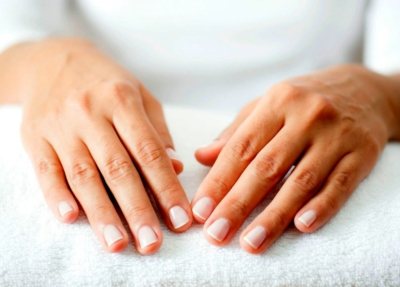
Recovery time depends on the severity of the injury and the speed of recovery.
- In cases of non-infectious etiology, therapy lasts up to six months.
- The treatment period for mycotic lesions lasts from three months to a year. Treatment must be complete, only then is absolute recovery possible.
- If onycholysis appears as a result of existing diseases, then complex treatment is prescribed and the treatment process becomes more complicated.
- The growth of new nail plates lasts on average from 3 to 5 months.
Forms and stages of onycholysis
There are several types of onycholysis:
- dermatological;
- traumatic;
- fungal;
- systemic;
- endocrine;
- allergic;
- bacterial.

Onycholysis can also be partial or complete. In the first option, the nail moves away from the nail bed only in a separate area, and in the second, the process can spread to the entire surface of the nail.
The disease occurs in stages:
- stage of disease development;
- stable stage without progression;
- subsidence of the dystrophic process;
- regression stage;
- complete recovery.
Prevention
In matters of prevention, methods and regularity of daily care for the skin and nails of the hands are given first place. The main points are moisturizing the skin of the hands and performing a manicure in a timely manner.
If self-examination reveals any changes in the nail plate, you should immediately consult a doctor and remember whether there were any traumatic effects in this area.
Prevention rules:
- cleanliness;
- careful treatment of nails and absence of injuries;
- use of quality care products;
- Wear gloves when working with harmful chemicals;
- good nutrition;
- absence of negative psychological factors, lack of sleep;
- maintenance therapy of chronic diseases.
If you still suspect the presence of onycholysis, you should immediately consult a specialist. At the initial stage, the prognosis is very favorable, but taking into account possible complications in the form of cosmetic defects.
Eliminating symptoms
Tell your doctor or nurse if you have any symptoms of nail changes. You may be prescribed medication to relieve your condition.
Follow the recommendations below to help resolve these symptoms.
It is forbidden:
- take hot baths and immerse your hands or feet in hot water;
- wear tight gloves, socks, tights or shoes;
- doing anything that puts friction or pressure on your nails, such as walking long distances or wearing tight shoes;
- biting or tearing off nails.
Need to:
- Tell your doctor if you have diabetes, vascular disease, peripheral neuropathy, or an autoimmune disease. This may increase the risk of skin breakdown, slow wound healing, and infection.
- Ask your doctor or nurse if you can use cold compresses on your hands and feet while you are receiving chemotherapy. If so, start using them 15 minutes before each chemotherapy infusion and leave for 15 minutes after the end of the infusion. For more information, ask your nurse for the resource entitled Cooling your nails during taxane chemotherapy treatment.
- Eucerin®;
Other recommendations
- Use biotin (Appearex®) for brittle nails.
- If necessary, consult a podiatrist. A podiatrist is a doctor who specializes in treating feet, ankles, and legs.
- If you have any signs or symptoms of infection, take a 15-minute soak in your fingers and toes in the evenings with a mixture of equal parts white vinegar and tap water. Signs and symptoms of infection include: redness;
- secretion of fluid that may have an unpleasant odor;
- hot, hard, or painful skin;
- temperature rises to 100.4°F (38°C) or higher;
- chills.
Call your doctor if you have any signs or symptoms of infection.
to come back to the beginning
Folk remedies
In folk medicine, there are a sufficient number of recipes for combating nail detachment, based on strengthening baths and lotions, which are summarized in the table.
| Means | Mode of application |
| Salt bath with potassium permanganate | For 20-30 minutes. A bath is made in which 1-2 grams are dissolved. potassium permanganate and 1 tbsp. l. sea salt. Then the hands are dried and a medicinal ointment is applied to the affected areas. |
| Lotion with a mixture of oil and garlic | It is necessary to crush 5 cloves of garlic and mix with butter in a 1:1 ratio. The mixture is applied to the affected area, rubbing in. |
| Iodine | The nail plates are smeared with the product overnight. |
| Propolis | Propolis tincture with alcohol is used as a night lotion. |
| Herbal bath with oak bark | 3 tbsp. l. bark mixed with 1 tbsp. l. celandine, 1 tbsp. l. lilac flowers, 1 tbsp. l. calendula. The mixture is poured into 2 tbsp. boiling water and heat in a water bath for about 10 minutes. In the prepared solution for 20 minutes. make baths. |
Features of therapy in children
It is important to monitor the condition of the skin around the nails in children. A small wound can cause a bacterial or viral infection. Particular concern should be shown if the baby’s nail darkens and peels off from the bed.
The causes of onycholysis in children are similar to those in adults. The differences lie in treatment tactics - for bacterial and fungal infections, if possible, it is necessary to limit yourself to local drugs and abandon systemic ones.
The course of treatment for fungal infection is at least 3 months. Every day, antifungal ointment is rubbed into the nails and affected areas of the skin. The most popular drugs that can be used for children are:
- Clotrimazole.
- Ketoconazole.
- Lamisil.
For bacterial infections, antibiotics are prescribed. The choice of drug depends on the baby’s age, weight and the presence of concomitant diseases. In case of extensive damage, the nail plate is removed, but this procedure is carried out only in a hospital setting. Throughout therapy, it is important to organize proper nutrition and, if necessary, take multivitamin complexes.
